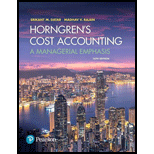
Methods of joint-cost allocation, comprehensive. Kardash Cosmetics purchases flowers in bulk and processes them into perfume. From a certain mix of petals, the firm uses Process A to generate Seduction, its high-grade perfume, as well as a certain residue. The residue is then further treated, using Process B, to yield Romance, a medium-grade perfume. An ounce of residue typically yields an ounce of Romance.
In July, the company used 25,000 pounds of petals. Costs involved in Process A, i.e., reducing the petals to Seduction and the residue, were:
The additional costs of producing Romance in Process B were:
During July, Process A yielded 7,000 ounces of Seduction and 49,000 ounces of residue. From this, 5,000 ounces of Seduction were packaged and sold for $109.50 an ounce. Also, 28,000 ounces of Romance were processed in Process B and then packaged and sold for $31.50 an ounce. The other 21,000 ounces remained as residue. Packaging costs incurred were $137,500 for Seduction and $196,000 for Romance. The firm has no beginning inventory on July 1.
If it so desired the firm could have sold unpackaged Seduction for $56 an ounce and the residue from Process A for $24 an ounce.
- 1. What is the joint cost of the firm to be allocated to Seduction and Romance?
Required
- 1. Under the physical measure method, how would the joint costs be allocated to Seduction and Romance?
- 2. Under the sales value at splitoff method, what portion of the joint costs would be allocated to Seduction and Romance, respectively?
- 3. What is the estimated net realizable value per ounce of Seduction and Romance?
- 4. Under the net realizable value method, what portion of the joint costs would be allocated to Seduction and Romance, respectively?
- 5. What is the gross margin percentage for the firm as a whole?
- 6. Allocate the joint costs to Seduction and Romance under the constant gross-margin percentage NRV method.
- 7. If you were the manager of Kardash Cosmetics, would you continue to process the petal residue into Romance perfume? Explain your answer.
Learn your wayIncludes step-by-step video

Chapter 16 Solutions
Horngren's Cost Accounting: A Managerial Emphasis (16th Edition)
Additional Business Textbook Solutions
Foundations Of Finance
Macroeconomics
Operations Management
Gitman: Principl Manageri Finance_15 (15th Edition) (What's New in Finance)
MARKETING:REAL PEOPLE,REAL CHOICES
Financial Accounting: Tools for Business Decision Making, 8th Edition
- Solve clearly with correct dataarrow_forwardPROBLEM E Mulles, the owner of a successful fertilizer business, felt that it is time to expand operations. Mulles offered to form a partnership with Lucena, the owner of a nearby warehouse. The partnership would be called Mulles & Lucena Storage and Sales. Lucena accepted Mulles' offer and the partnership was formed on July 1,2024. Presented below is the trial balance for Mulles Fertilizer Supply on June 30, 2024: Cash Accounts Receivable Allowance for Uncollectible Accounts. Inventory Prepaid Rent Store Equipment Accumulated Depreciation Notes Payable Accounts Payable Mulles, Capital Total P 229,500 2,103,000 P 117,000 1,012,500 29,250 390,000 P3,764,250 97,500 330,000 505,500 2,714,250 P3,764,250 The partners agreed to share profits and losses equally and decided to invest an equal amount in the partnership. Lucena and Mulles agreed that Lucena's land is worth P500,000 and his building P1,450,000. Lucena is to contribute cash in an amount sufficient to make his capital account…arrow_forwardPLEASE HELP. ALL RED CELLS ARE INCORRECT. NOTICE, REVENUE ACCOUNTS ARE IN THE DROPDOWN!arrow_forward
- Journalize these transactions, also post the transcations to T-accounts and determine month-end balances. Finally prepare a trail balance.arrow_forwardSuppose during 2023, BlueStar Shipping reported the following financial information (in millions): Net Sales: $40,000 Net Income: $150 Total Assets at Beginning of Year: $26,000 • Total Assets at End of Year: $24,800 Calculate the following: (a) Asset Turnover (b) Return on Assets (ROA) as a percentagearrow_forwardPlease fill all cells! I need helparrow_forward
- Hilary owns a fruit smoothie shop at the local mall. Each smoothie requires 1/2 pound of mixed berries, which are expected to cost $5.50 per pound during the summer months. Shop employees are paid $7.00 per hour. Variable overhead consists of utilities and supplies, with a variable overhead rate of $0.12 per minute of direct labor time. Each smoothie should require 4 minutes of direct labor time. Determine the following standard costs per smoothie: Direct materials cost Direct labor cost Variable overhead costarrow_forwardgeneral accountingarrow_forwardThe following financial information is provided for Brightstar Corp.: Net Income (2023): $500 million Total Assets on January 1, 2023: $3,500 million Total Assets on December 31, 2023: $4,500 million What is Brightstar Corp. _ s return on assets (ROA) for 2023? A. 11.80% B. 12.50% C. 13.20% D. 14.00%arrow_forward
- PLEASE FILL ALL CELLS. ALL RED CELLS ARE INCORRECT OR EMPTY.arrow_forwardAssume Bright Cleaning Service had a net income of $300 for the year. The company's beginning total assets were $4,500, and ending total assets were $4,100. Calculate Bright Cleaning Service's Return on Assets (ROA). A. 6.50% B. 7.25% C. 6.98% D. 5.80%arrow_forwardwhat is the investment turnover?arrow_forward
 Cornerstones of Cost Management (Cornerstones Ser...AccountingISBN:9781305970663Author:Don R. Hansen, Maryanne M. MowenPublisher:Cengage LearningPrinciples of Accounting Volume 2AccountingISBN:9781947172609Author:OpenStaxPublisher:OpenStax College
Cornerstones of Cost Management (Cornerstones Ser...AccountingISBN:9781305970663Author:Don R. Hansen, Maryanne M. MowenPublisher:Cengage LearningPrinciples of Accounting Volume 2AccountingISBN:9781947172609Author:OpenStaxPublisher:OpenStax College Managerial Accounting: The Cornerstone of Busines...AccountingISBN:9781337115773Author:Maryanne M. Mowen, Don R. Hansen, Dan L. HeitgerPublisher:Cengage Learning
Managerial Accounting: The Cornerstone of Busines...AccountingISBN:9781337115773Author:Maryanne M. Mowen, Don R. Hansen, Dan L. HeitgerPublisher:Cengage Learning Managerial AccountingAccountingISBN:9781337912020Author:Carl Warren, Ph.d. Cma William B. TaylerPublisher:South-Western College Pub
Managerial AccountingAccountingISBN:9781337912020Author:Carl Warren, Ph.d. Cma William B. TaylerPublisher:South-Western College Pub



